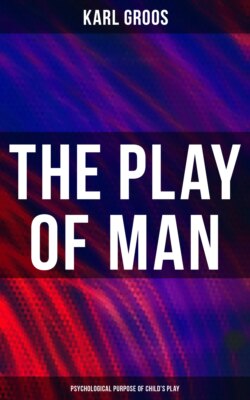Читать книгу The Play of Man - Psychological Purpose of Child's Play - Karl Groos - Страница 20
(c) Perception of Form
ОглавлениеRecognition, the first requirement for reproduction, is dependent on perception of form. Later, in considering mental experimentation, I shall return to this subject and treat it more fully. Here I will make only the general statement that the visible form of objects is of higher biological value to the exceedingly important faculty of recognition than is colour or brilliancy. Evidently the child has a very special interest in form, or he could not without great effort distinguish the meaning of simple outline at the relatively early age when we find him doing so. It is remarkable how indifferent little children are to gay colour in pictures. Konrad Lange has treated the subject exhaustively in his well-known book, and Sigismund says: “I can not affirm that there is any preference for coloured pictures at this age (two years). When I laid before the child copies of the same picture done in colours and in black and white he seemed to regard them with equal pleasure.”130 This indifference is displayed, too, by children who take the liveliest interest in a gaudy ribbon or bright flowers; therefore it seems to me probable that the child is so concentrated in the apperception of form that he has no attention left to bestow on the colour—a legitimate argument for the importance of form in recognition. Very striking, too, is the child’s extraordinary capacity for illusion in the observation of form. When Souriau says, “Regarder un dessin, c’est voir des chimères dans les nuages,” he rightly adds that it applies with special force to children.131 “Mere outlines,” says Sigismund, “serve for any object of that general shape. My little one calls a square a bonbon, and a circle a waiter.”132 Preyer’s son called a square drawn on paper with a red pencil a window, a triangle was a roof, and a circle a ring.133 All this goes to show how strongly the child’s interest is concentrated on the apperception of form.134 Such a capacity for illusion often has notable results. Thus Marie G——, when three years old, saw a painting which represented the early morning just before sunrise, and asked me to turn the picture round to see if the sun was on the other side.
Recognition and illusion are two of the threads from which the complex web of æsthetic enjoyment is woven. When the child begins to take pleasure in form it is difficult to say, and more difficult still to determine, when the æsthetic personification, which is so important to adults, arises. Experiment may, however, throw some light on both questions. Marie G—— was five years old when I first attempted something of the sort with her. I showed her a straight line, and near it an irregular one, and, in order to excite her interest, told her that I wanted to keep one of them and was in doubt as to which it should be. She pointed at once to the straight one—“I should keep that.” Well-drawn equilateral triangles were preferred to irregular ones, but she gave a characteristic reason for choosing the uneven quadrilateral instead of a perfect rectangle—because, she said, it looked like a hat. Here the less pleasing form was preferred for the sake of its meaning; she was still quite clear in her idea of regularity. She asked me, for instance, to draw “some straight figures and some of the other kind.” By straight she meant regular—she called a perfect circle straight. We thus find in a child the æsthetic rule operative—namely, that formal regularity is agreeable. Personification of the figure by children is also a subject for experimentation. German students of æsthetics found out long ago that the object of our enjoyment is endowed by our imagination with personal attributes analogous to our own. “We conceive of all natural objects,” says Wölfflin, “as analogous to our physical organism.”135 One of the first requirements of our organism is that it shall maintain its equilibrium, and accordingly an elementary fact in our personification of natural objects is that a distorted figure causes us an unpleasant feeling of disturbed equilibrium. I showed the five-year-old Marie G—— these two figures, and asked which she would rather have. Unhesitatingly she pointed to A. “Why?” I asked. “Because it stands on the point.” “But the other one stands on its point too.” “Yes, but this” (pointing to the angle S) “is so low.” She played with the squares, and turned them so that they rested on the horizon line. “Now they hang down,” she said; “but this one” (pointing to B) “is just willing to come down.” That the child at play personifies all possible objects is a familiar fact, and we here find that they can conceive of even abstract figures according to physical analogies.
